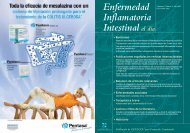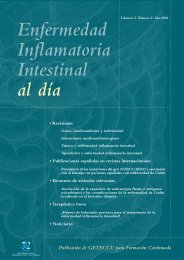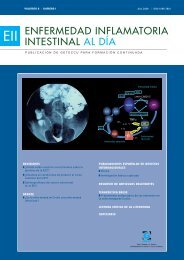Número 1 - EII al dÃa
Número 1 - EII al dÃa
Número 1 - EII al dÃa
Create successful ePaper yourself
Turn your PDF publications into a flip-book with our unique Google optimized e-Paper software.
pueden presentar cef<strong>al</strong>eas, náuseas, vómitos, dispepsia,<br />
dolor abdomin<strong>al</strong>, artr<strong>al</strong>gias, mi<strong>al</strong>gias o reacciones<br />
<strong>al</strong>érgicas cutáneas. Otros efectos adversos como aplasia<br />
medular, infertilidad, pericarditis, pneumonitis,<br />
pancreatitis, hepatitis o f<strong>al</strong>lo hepático son mucho<br />
menos frecuentes. Los nuevos aminos<strong>al</strong>icilatos, en<br />
gener<strong>al</strong> muy bien tolerados, presentan escasos efectos<br />
adversos, exceptuando la ols<strong>al</strong>azina que se relaciona<br />
con la aparición de diarrea secretora (36)<br />
Hasta la fecha se han publicado muy pocos casos de<br />
hepatotoxicidad en relación con la toma de aminos<strong>al</strong>icilatos,<br />
en su mayoría por sulfas<strong>al</strong>azina. La mayoría de<br />
los casos publicados describen una lesión hepatocelular<br />
aguda (hepatitis aguda), aunque excepcion<strong>al</strong>mente<br />
también han sido descritos cuadros colestáticos (37) .<br />
Recientemente se reev<strong>al</strong>uaron todos los efectos adversos<br />
en relación con la toma de aminos<strong>al</strong>icilatos en<br />
pacientes con artritis reumatoide o <strong>EII</strong>. Para ello se<br />
an<strong>al</strong>izaron todas las reacciones adversas medicamentosas<br />
que se constataron entre los años 1991 y 1998 a<br />
través del Comité de Vigilancia de Medicamentos del<br />
Reino Unido (38) . No se estudiaron los relacionados con<br />
los aminos<strong>al</strong>icilatos más recientes (ols<strong>al</strong>azina y b<strong>al</strong>s<strong>al</strong>azina)<br />
por su reducido número de prescripciones y efectos<br />
adversos constatados. La incidencia glob<strong>al</strong> de hepatotoxicidad<br />
por cada millón de prescripciones fue de 6<br />
casos para la sulfas<strong>al</strong>azina y de 3,2 casos para la mes<strong>al</strong>azina.<br />
La incidencia, 3,1 casos por cada millón de prescripciones,<br />
fue menor en los pacientes con <strong>EII</strong> en relación<br />
con la artritis reumatoide.<br />
En resumen, de los estudios re<strong>al</strong>izados hasta ahora, se<br />
deduce que no es necesaria la vigilancia de las transaminasas<br />
en los pacientes a los que se les pautan aminos<strong>al</strong>icilatos.<br />
BIBLIOGRAFÍA<br />
1. Podolsky DK. Inflammatory bowel disease. N Engl J Med 2002;347:417-<br />
29.<br />
2. Lewis JH. Drug-induced liver disease. Med Clin North Am 2000;84:1275-<br />
311.<br />
3. Dossing M, Sonne J. Drug-induced hepatic disorders. Incidence, management<br />
and avoidance. Drug Saf 1993;9:441-9<br />
4. Benichou C. Criteria of drug-induced liver disorders. Report an internation<strong>al</strong><br />
consensus meeting. J Hepatol 1990;11:272-6.<br />
5. Larrey D. Drug-induced liver diseases. J Hepatol 2000(Suppl.1);32:77-88.<br />
6. Andrade RJ, Lucena MI, Fernández MC et <strong>al</strong>. Drug-induced liver injury: an<br />
an<strong>al</strong>ysis of 461 incidences submitted to the Spanish registry over a 10-<br />
year period. Gastroenterology 2005;129:512-21<br />
7. Carter MJ, Lobo AJ, Travis SP; IBD Section, British Society of<br />
Gastroenterology. Guidelines for the management of inflammatory<br />
bowel disease in adults. Gut 2004;53 Suppl 5:1-16.<br />
8. Lennard L. TPMT in the treatment of Crohn’s disease with azathioprine.<br />
Gut 2002;51:143-6.<br />
9. Present DH, Meltzer SJ, Krumholz MP, Wolke A, Korelitz BI. 6-<br />
Mercaptopurine in the management of inflammatory bowel disease:<br />
short- and long-term toxicity. Ann Intern Med 1989;111:641-9<br />
10. Marion JF. Toxicity of 6-mercaptopurine/azathioprine in patients with<br />
inflammatory bowel disease. Inflamm Bowel Dis 1998;4:116-7.<br />
11. Cuffari C, Theoret Y, Latour S, Seidman G. 6-Mercaptopurine metabolism<br />
in Crohn’s disease: correlation with efficacy and toxicity. Gut<br />
1996;39:401-6.<br />
12. Fraser AG, Orchard TR, Jewell DP. The efficacy of azathioprine for the treatment<br />
of inflammatory bowel disease: a 30 year review. Gut 2002;50:<br />
485-9<br />
13. George J, Present DH, Pou R, Bodian C, Rubin PH. The long-term outcome<br />
of ulcerative colitis treated with 6-mercaptopurine. Am J<br />
Gastroenterol 1996;91:1711-4.<br />
14. Ansari A, Hassan C, Duley J et <strong>al</strong>. Thiopurine methyltransferase activity<br />
and the use of azathioprine in inflammatory bowel disease. Aliment<br />
Pharmacol Ther 2002;16:1743-50.<br />
15. Goldstein ES, Marion JF, Present DH. 6-Mercaptopurine is effective in<br />
Crohn’s disease without concomitant steroids. Inflamm Bowel Dis 2004;<br />
10:79-84.<br />
16. Bastida G, Nos P, Aguas M et <strong>al</strong>. Incidence, risk factors and clinic<strong>al</strong> course<br />
of thiopurine-induced liver injury in patients with inflammatory bowel<br />
disease. Aliment Pharmacol Ther 2005;22:775-82.<br />
17. Lopez-Sanroman A, Bermejo F, Carrera E, Garcia-Plaza A. Efficacy and<br />
safety of thiopurinic immunomodulators (azathioprine and mercaptopurine)<br />
in steroid-dependent ulcerative colitis. Aliment Pharmacol Ther<br />
2004;20:161-6.<br />
18. Weersma RK, Peters FT, Oostenbrug LE et <strong>al</strong>. Increased incidence of azathioprine-induced<br />
pancreatitis in Crohn’s disease compared with other<br />
diseases. Aliment Pharmacol Ther 2004;20:843-50.<br />
19. Larrey D. Epidemiology and individu<strong>al</strong> susceptibility to adverse drug reactions<br />
affecting the liver. Semin Liver Dis 2002;22:145-55.<br />
20. Andrade RJ, Lucena I, González R. Hepatitis Inducida por tóxicos.<br />
Gastroenterología y Hepatología integrada 2003;2:197-203.<br />
21. Kaplowitz N. Drug-induced liver disorders: implications for drug development<br />
and regulation. Drug Saf 2001;24:483-90.<br />
22. Dubinsky MC, Lamothe S, Yang HY, Targan SR, Sinnett D, Theoret Y,<br />
Seidman EG. Pharmacogenomics and metabolite measurement for 6-<br />
mercaptopurine therapy in inflammatory bowel disease.<br />
Gastroenterology 2000;118:705-13.<br />
23. Menghini VV, Arora AS. Infliximab-associated reversible cholestatic liver<br />
disease. Mayo Clin Proc 2001;76:84-6.<br />
24. S<strong>al</strong>eem G, Li SC, MacPherson BR, Cooper SM. Hepatitis with interface<br />
inflammation and IgG, IgM, and IgA anti-double-stranded DNA antibodies<br />
following infliximab therapy. Arthritis Rheum 2001;44:1966-8.<br />
25. Colombel JF, Loftus EV Jr, Tremaine WJ et <strong>al</strong>. The safety profile of infliximab<br />
in patients with Crohn’s disease: the Mayo clinic experience in 500<br />
patients. Gastroenterology 2004;126:19-31.<br />
26. Esteve M, Saro C, Gonz<strong>al</strong>ez-Huix F, Suarez F, Forne M, Viver JM. Chronic<br />
hepatitis B reactivation following infliximab therapy in Crohn’s disease<br />
patients: need for primary prophylaxis. Gut 2004;53:1363-5.<br />
27. Doménech E, Esteve M, Gomollón F, Hinojosa J, Panes J, Obrador A,<br />
Gassull. MA; Grupo Español de Trabajo en Enfermedad de Crohn y Colitis<br />
Ulcerosa. GETECCU-2005 recommendations for the use of infliximab<br />
(Remicade) in inflammatory bowel disease. Gastroenterol Hepatol<br />
2005;28:126-34.<br />
28. Feagan BG, Fedorak RN, Irvine EJ et <strong>al</strong>. A comparison of methotrexate<br />
with placebo for the maintenance of remission in Crohn’s disease. North<br />
6 • Enfermedad Inflamatoria Intestin<strong>al</strong> <strong>al</strong> día - Vol. 5 - Nº. 1 - 2006











